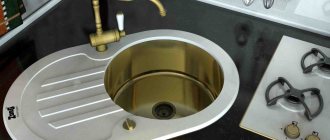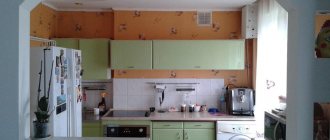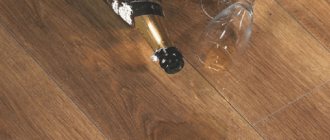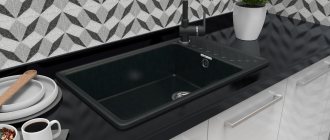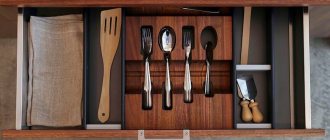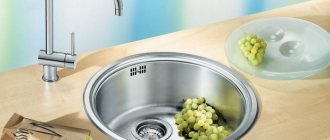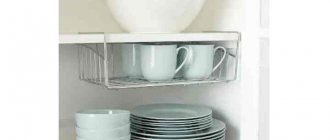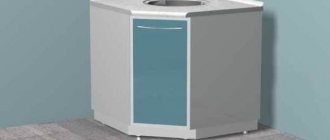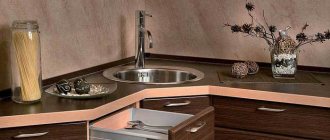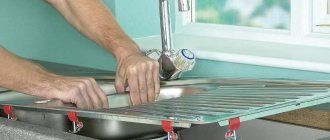If you want to enjoy the process of cooking, you should arrange your kitchen so that all the necessary items have good functionality and are always at hand. The sink plays an important role in shaping the interior of a kitchen space.
According to a survey conducted among housewives, the most comfortable, due to its compact size and design features, is a corner sink, the features of which we will tell you about in this article.
Standard kitchen sink sizes
Everyone's preferences are different, so there is a wide range of sizes to choose from. Small bowls are convenient for washing small cutlery, such as tea saucers or cups (you can’t fit a lot of dishes at once).
There are also large products from 80 cm in length. They are convenient for washing large dishes or for defrosting a hefty piece of meat.
The choice depends on food preferences and the presence or absence of a dishwasher.
The standard dimensions of a kitchen sink are 55-60 cm wide and 50-55 cm deep. At the bowl, it varies from 16 to 19 cm. They are convenient when washing forks, spoons, vegetables and cleaning them.
If you prefer to cook dishes that require bulky utensils, then your choice of kitchen sink bowl size will depend on the size of the largest baking sheet or frying pan in your home. A traditional small kitchen sink measures 45 cm wide.
Cabinet and tabletop size
Firstly, the bowl cannot be larger than the cabinet. A smaller size is allowed, but not a larger one.
To choose the right size sink, you need to have 2 measurements:
- Width of the cabinet frame.
- All measurements of the area where you plan to place the sink (if it has a drain). For ease of use, you need to take into account the fact of who you are - right-handed or left-handed? The wing should be located on the corresponding side.
To ensure that when choosing kitchen sinks, they have the appropriate dimensions for the cabinet, you need to follow some general tips:
- Do not allow the sides to press tightly against the wall. You need to leave a gap of 5 cm. Example: the frame of the cabinet is 50 cm wide, which means it is possible to install a sink 45 cm wide (the size of the wing is not taken into account).
- Do not allow the sink to be adjacent to the outer edge of the countertop by more than 5 cm. That is, there is no need to place it close (in size) to the cabinets. Otherwise, while washing dishes, water splashes will fly onto clothes and the floor. But you also don’t need to install it very far away, otherwise it will be inconvenient.
- An overhead kitchen sink (if the choice fell on it) should have dimensions corresponding to the dimensions of the cabinet (example: the cabinet should be 60x60 cm and the sink should be 60x60 cm).
Bowl depth
Some tips for choosing depth:
- The optimal depth of the bowl is 16-19 cm. It is capacious and does not allow water to splash. This is the volume most products have.
- Sinks with a depth of more than 20 cm are good when you constantly use large containers or baking trays. For domestic use, this is not the best idea, since your back will be strained every time. But this can be corrected by raising the cabinet higher.
- Shallow bowls (less than 16 cm) are only good in bathrooms. Because when washing dishes, water splashes will scatter onto clothes, the floor and the countertop.
- If the sink has a diameter of less than 45 cm, then its depth, in most cases, reaches 20 cm or more.
Number of sink bowls
The number of bowls can be completely different. There are sinks with one, two and three sections. Sinks with more than 1 section are especially good and practical: in the first section you can wash dishes, and in the next one you can rinse them. If the kitchen space allows you to place a larger sink (with 2 or 3 sections), then it is better to install just this one, because using these is much more convenient.
To install multi-section sinks, you need a cabinet frame at least 80 cm wide. This is usually required for sinks with 2-3 bowls. Or you can install such a sink on a corner.
If the space is neither large nor small, then one-and-a-half sinks are suitable. Their length starts from 60 cm. That is, there are 2 bowls, just one of them is 2 times smaller than the first.
Number of bowls
Sinks come in single, one-and-a-half, double and three-section types. The latter types are convenient because they provide greater freedom of action when working in the kitchen. For example, you can wash dishes and at the same time defrost meat or rinse vegetables. Such solutions take up more space, but the comfort they provide is very noticeable. The width of the furniture frame for such sinks should be at least 80 cm. If the second section is narrow, that is, a one-and-a-half model, then it will take up at least 60 cm in length. This option is suitable for small-sized kitchens.
Types of kitchen sinks
Decide where you would like to install the sink: is there room for it on a straight part of the countertop or would it be more convenient for you to use it in a corner? Let's look at the main types.
Direct
The kitchen cabinet under the sink, which has a straight design, has the following dimensions in length: 60-80 cm with two doors; 30-40 cm with one door. Suitable for spacious rooms.
Straight cabinets with sinks are easy to use due to the ease of access to them (unlike some corner models). But oversized cabinets are convenient when there are special drawers. Without them, it is difficult to get the things you need.
Large cabinets are made from oak or beech because they are the most durable.
Corner
The corner kitchen cabinet for the sink has standard dimensions or is made to order. This version of the cabinet is good for placing kitchen appliances, detergents or a water heating system on it.
Standard dimensions of a corner sink Corner planning solutions for the kitchen are rightfully considered the most ergonomic and functional. Largely thanks to the underlying triangle rule.
It is when this is observed that the housewife spends less time and effort walking along the work surface. The corner cabinet under the sink is traditional for Russian kitchens and rarely does anyone decide to abandon it. After all, it is from the corner that all water supply and drainage systems are connected. And transferring them is quite labor-intensive and not always justified.
https://youtube.com/watch?v=YJiuw9q8uFI
Types of corner cabinets:
- Straight side corner table. In fact, it is a standard kitchen module with one “muffled” door - a false panel. The most common option in modular kitchens.
- L-shaped corner table-pedestal. The most flexible option in terms of resizing. Most often it is equipped with a transforming door, which significantly expands access to the inside of the cabinet.
- Trapezoidal table-pedestal for sink. The most bulky “classic” version of a corner cabinet under the sink. It is not recommended to install it in small kitchens, as it “eats up” a lot of usable space.
The sizes of the corner sink in the kitchen set are different, because there are sinks with an acute angle and with a beveled one.
The first option is distinguished by the presence of two doors. From the outside, such a cabinet looks like 2 single drawers, but when you open the doors, you get one large drawer with shelves. The dimensions of the corner sink kitchen cabinets are as follows: corner – 87 x 87 cm; side shelf depth – 44 cm; height – 81.5 cm.
Corner sinks with a beveled corner are larger than the previous ones, but in fact more convenient. Their parameters: angle – 85 x 85 cm; shelf depth – 60 cm. To simplify cleaning, legs are included in the package (their length is 10 cm).
Invoice
This type replaces the tabletop. The format matches the cabinets. In addition to the sink, the package also includes separate areas for installing a faucet.
One of the varieties of the overhead system is a sink with an extensive wing. It connects to the main tabletop. This arrangement of the corner is cumbersome in appearance, but every single millimeter of space is used to advantage.
But this type is imperfect, since water will be poured into the joints between the parts of the kitchen unit. Accordingly, the furniture will quickly deteriorate.
Mortise invoice
For installation in the tabletop, you need to make holes in accordance with the dimensions of a certain model. The frame or wing should fit onto the table and rise up. The main thing is to perform high-quality processing of the docking points.
For installation in the tabletop, you need to make holes in accordance with the dimensions of a specific model
Mortise
Built-in kitchen sinks have different dimensions: they are not located above the countertop, but, on the contrary, go deeper inside. This type is expensive, and the installation process is difficult and long, since there are different sizes, and countertops for undermount kitchen sinks are mostly made of artificial stone.
Types of designs: shape and dimensions
The shape of the sink influences its choice, since it must match the style of the kitchen, be comfortable, functional, and spacious. And this is a description of different forms, since the assessment of these parameters is individual for everyone.
Round
The most convenient round kitchen sink measures 45-60 cm in diameter and 16-20 cm in depth. This option is good for small kitchens. Round sinks look neat and laconic.
It is not recommended to purchase a sink that is too shallow or too deep. Because of the first, when used, you and everyone around will be in the water, and because of the second, back pain will be guaranteed.
Oval
Oval sinks are models with a wing. They are presented in formats from 56 to 78 cm (length) and from 44 to 51 cm (width).
The oval shape has many advantages:
- Convenient to wash dishes of any size (both large and small).
- Compactness.
- Dirt will not collect in the corners, since there are none.
- Variety of materials.
- Fits into any interior.
Square and rectangular
These are classics, but due to the use of new materials and manufacturing technologies, square and rectangular sinks fit well into the Art Nouveau style.
Among the parameters, the following are popular: 50 x 60; 60 x 60; 80 x 60; 100 x 60; 120 x 60 cm.
Trapezoidal
Traditional sizes: 90-112 cm (larger side), 40-70 cm (smaller side). The corner part of the kitchen unit for the sink should have dimensions of 90 x 90 cm.
The front of a trapezoidal sink is either concave or straight. You should not make the bedside table small, as the presence of small doors will complicate use.
Other forms
If you don’t like the usual forms, then you can do something unconventional. As a rule, this is done when there is no space at all or the concept of the room requires informal solutions.
The triangular sink is installed directly into the corner part of the set. It takes up minimal space. And if a non-standard shape is included in the kitchen concept, then they can order any shape, for example, a crescent-shaped sink.
Recommendations and life hacks for choosing a kitchen sink
- To choose the right size of kitchen sinks, consider the cooking habits of your family - how often you wash dishes, how much you cook, and so on. For example, if the kitchen is small and the family is not large, then choose kitchen sinks with a width of 45 cm;
- Additionally, you can choose a small sink if your kitchen has a dishwasher. However, the depth of the sink should allow large pots and baking trays to be rinsed in it;
- Pay attention not only to the length, width, depth, but also to the thickness of the material and the height of the sides. A mortise sink with higher sides will be more practical, and the thickness of the stainless steel – the thicker the better (acceptable thickness of stainless steel is 1.2 mm or more);
- Much depends on the type of mixer chosen. For example, if you want a faucet built into the countertop, then the size of the sink should be selected taking into account the space for it;
- The standard sizes of cabinets are from 60 to 35 cm. Of course, it is important to first install the cabinet, and then select a sink for it;
- And one more thing - if your set does not have room for a three-section spacious sink, then use a faucet equipped with a pull-out “shower”.
Sink sizes: how to choose the required dimensions
The parameters of the kitchen sink are a very important indicator, according to which the required option is selected. Before buying a sink, you need to measure the free space in the corner. It is recommended to always allow for a small margin.
Before purchasing and installing a corner sink, be sure to carefully measure the location where it will be installed.
Corner models can differ in a wide variety of dimensions. For example, even a sink that is compact in width can have quite a significant depth. When choosing the size of a corner sink, there are several important factors to consider.
First of all, the selection of parameters is carried out in accordance with the size of the kitchen furniture itself. It is also very important to consider what kind of utensils owners most often use for cooking. In addition, you need to take into account the height of the tabletop.
Note! If the kitchen has a dishwasher, then purchasing a deep sink is not a prerequisite.
It is very important to choose the correct depth of the countertop. This determines whether water will flow outside the bowl when the tap is turned on. The optimal sink depth varies from 16 to 20 cm. These indicators are quite enough to ensure comfortable washing of dishes. There are several rules that allow you to choose the right size corner sink for your kitchen. Photos of various models are also recommended for study.
Externally, a small sink may well have significant depth, and vice versa
If the height of the kitchen sink cabinet is 85 cm, then it is strictly not recommended to purchase bowl models whose depth exceeds 20 cm. Such dimensions ensure convenient use of the sink. These sinks are suitable for washing not only plates, but also larger dishes (pans, pots, etc.).
Examples of location and design: photo design and video of sink installation
The size of the sink depends on various factors: shape, type, number of bowls, etc. When choosing, you need to pay attention to all aspects. The main thing is to choose one that is convenient for use. There are no objective assessments here, since comfort is understood differently for everyone.
What is the rationale for choosing a model?
Taking advantage of the space in the corner is an advantage of efficient space organization, where a small room will benefit. Successful placement of furniture in this area guarantees the formation of a spacious space.
Installing a kitchen set with a corner sink is a winning solution, since in this option it will be possible to use a voluminous cabinet for storing things, as well as the empty space of the corner area on the countertop.
Experienced housewives skillfully involve even the section of wall between the sink and the upper tier of cabinets into work. Here you can place a dish dryer, shelves for household chemicals and other necessary little things.
Using a corner to install a sink provides a choice of any type of sanitary ware. Sinks with this location are produced from all available materials.
The configuration, despite the modest dimensions of the room, can be chosen to suit your preferences. Even a product with several bowls will be placed without harming the usable space (which is unacceptable with a linear arrangement of containers) of a small room.
The corner sink in the kitchen is easy to use - the location does not limit movement, adjacent surfaces become accessible, and it becomes possible to correctly organize ergonomics.
Main types
Showing interest in sinks, many wonder what options there are in terms of shape and material of manufacture. Sinks with corner orientation are distinguished by a variety of configurations; variations with this arrangement can be made from standard materials and various shapes.
Material of manufacture
Common materials for the manufacture of plumbing products for the kitchen are:
- stainless steel;
- granite (natural, artificial);
- metal coated with enamel;
- ceramics.
Stainless steels are popular. The material is easy to work with, which is why manufacturers present a wide range of models. The sinks are resistant to temperature changes, household chemicals, and do not require complex maintenance.
Disadvantages of products made from this material: noise, accumulation of lime and soap deposits, instability to mechanical damage.
Over the past few years, buyers have shown increased interest in stone products. Granite corner sinks have many positive qualities. The products are not afraid of mechanical, temperature, chemical influences, are able to absorb noise, and retain their original appearance for a long time. These qualities are characteristic of objects made of natural stone and a mixture of composite and acrylic. But artificial granite requires careful handling.
Steel or cast iron coated with enamel has long been used in the manufacture of plumbing products. It is not often possible to find corner sinks made of these materials in a modern interpretation on sale. The products are not distinguished by their presentable appearance. But the sinks are durable, reliable, and have most of the standard advantages.
The disadvantage of the products is their high susceptibility to scratches, chips, and, after time, corrosion.
A corner sink in a kitchen is rare, but it can be made of ceramics. This material is more typical for bathroom plumbing. The products are highly environmentally friendly, resistant to mechanical damage, and have good noise insulation. Among the disadvantages is the weight of the products, which entails difficulties during installation and is not the lowest cost.
Shapes of corner sinks
A corner sink in a kitchen can have any shape. The most commonly used variations are:
- square;
- round;
- rectangular;
- triangular;
- oval.
The square shape is considered popular; sinks with such a bowl do not take up much space, so they are often used in small spaces.
Round shapes are less spacious, but convenient to use. Such bowls are compact, so they are preferable for small rooms.
Rectangular containers are similar to square ones, but are very bulky. Such options are chosen to expand the functionality of the product (use additional features).
The main bowl is rarely triangular or oval in shape; often such containers are additional. But an entire corner kitchen sink is often made based on these shapes.
Functionality
The dimensions of the sink are selected based on the parameters of the room and personal preferences. It is logical that the wider the bowl, the more convenient it is to work with it. Products with a single container have the most acceptable values of this parameter.
The depth of the bowl is also an important parameter. Small containers are fraught with excessive wetting of the nearby area. Very deep - guarantee increased load when working with it.
The number of bowls is no less important to ensure the proper functionality of the item. The more compartments a sink has, the more practical it is. Each section can be used for different purposes at the same time. The work process will go faster and more efficiently.
The existence of additional devices (cutting boards, food racks, dish dryers) helps improve actions. Any kitchen will benefit from the presence of technical innovations. The sink in the corner of a small kitchen especially needs them.
Choosing the shape of a corner kitchen sink: recommendations
One of the most important parameters of shells is their shape. There are both standard models of this plumbing equipment and less common options used for corner kitchens. A sink in a corner with incorrectly selected dimensions or configuration can cause many difficulties, so it is very important to study the possible options for product shapes:
- round;
- square;
- rectangular.
Related article:
Kitchen sink made of artificial stone: characteristics, features of choice and care
Features of the material. Models and colors of artificial stone sinks for the kitchen. Performance characteristics. Advantages and disadvantages.
Round sinks are very popular in the modern market. The advantage of such sinks is that they have a large volume, which is determined by the peculiarities of the shape. This sink harmonizes perfectly with a variety of interiors.
Round bowls have another serious advantage - they are quite compact. Therefore, experts recommend buying such models for small kitchen spaces. Round sinks, as a rule, are sold together with a corner module for the kitchen under the sink. The absence of corners helps to improve the hygienic performance of this design, since it is less prone to the accumulation of contaminants. It is also worth noting that round sinks have a wide range of models.
The shape and depth (volume) of the corner sink bowl can vary significantly
The classic version of sinks is square. Such products are highly functional in any kitchen. The dimensions of the room in this case do not play a role. These sinks are suitable for both spacious kitchens and small rooms.
Square models most often have a side wing, which is necessary for storing dishes, but they can be sold without this element. Corner sinks with a cabinet having this shape are also installed directly into the countertop. Thus, square models are the optimal solution. The cost of such sinks is quite reasonable.
Rectangular bowls for washing dishes are currently considered the most popular. They are distinguished by functionality and versatility. Such models can be overhead or mortise.
Advantages and disadvantages of corner models
Kitchens with a corner sink are rated as more functional. This is due to a number of advantages inherent in a sink located at the junction of the walls.
The main ones:
- significant space savings;
- expansion of space in the corner;
- increasing the convenience of operations;
- wide selection of types of sinks.
Due to these criteria, it is advisable to install the sink in an empty corner. In this case, a ready-made kitchen set with a corner sink is most preferable. This way you don’t have to worry about the parameters of objects or fixing the sink. The corner sink in the kitchen with the cabinet should be correctly combined. Therefore, when selecting each item separately, it is necessary to take into account many nuances.
Among the disadvantages of corner structures are often identified:
- smaller bowl size than linear modifications;
- complicating the use of cabinets adjacent to the sink;
- deterioration of the situation with maintaining the cleanliness of the corner.
The nature of the arrangement does not allow combining large bowls. These will be either 2 equal small containers, or 1 larger and the other smaller. Therefore, it is better to prefer a single model.
The approach to the sink is not convenient when using adjacent cabinets at the same time. Open doors block space and prevent free access. This is true when 2-3 people work in the kitchen at a time.
If you need to reach distant objects in the corner, you will have to use additional devices. The same goes for cleaning this space.
Kitchen with corner sink: where to place the sink
The location of the kitchen sink is selected taking into account the ease of its use. The sink in bathrooms, as a rule, is located in such a way that its entire body is located above the cabinet. This option is not suitable for the kitchen, since in this case it will be difficult to wash the dishes.
Placing a sink in a corner makes moving around the kitchen more efficient
Before installing these devices, it is recommended to study ready-made placement options, which can be seen in the photo. The prices of corner kitchen sinks and their capabilities are directly related. The corner type design allows you to create two work areas, which is very convenient. The advantages of this arrangement are very significant, since standard sink options do not allow you to cook several dishes at once.
Note! The angular position of the sink is not always a winning solution. For example, this option is not suitable for short people due to the presence of a “dead zone”.
If cooking in the kitchen is carried out by more than one person, then in this case it is also better to refuse to purchase a corner sink. The cabinet under the sink is selected depending on the dimensions of the bowl itself.
Nowadays, placing the kitchen sink near the window is gaining popularity. This option for placing plumbing fixtures is common in European countries. In this case, the stove and countertop are located along the wall.
Corner kitchen sink located by the window
Design features of corner sinks: color and accessories
The choice of color depends on the style of the kitchen. A wide variety of sink models allows you to choose the necessary colors that will harmonize with the design of your kitchen unit. The corner cabinet for the sink is also selected according to this principle.
The classic version of the bowl is white. Such sinks are suitable for almost any kitchen, which is why they are popular among buyers. Another common type is metallic-colored products. They are made of stainless steel.
Purchasing a stone sink will allow you to choose not only the right color, but also the design. Models made of artificial black marble look elegant and presentable. Stone products can come in a variety of colors, but neutral shades are the most popular. A corner kitchen sink with a cabinet, made of gray and white stone, will decorate any room, regardless of its style.
When purchasing such plumbing fixtures in stores, they often offer to buy additional components for it. Some accessories can be very useful in everyday life. Most often, containers are sold along with sinks that are used to store brushes, soap dishes, as well as boards for cleaning and cutting vegetables and fruits.
Today there are a wide variety of sink models on the market, so you can choose one that suits any interior design.
Features of choice
When choosing a suitable model, you need to pay attention to the material from which the product is made. Both technical characteristics and the nature of care, appearance of the item, and compliance with the environment depend on the choice.
The next important aspect is the device configuration. Ease of use of the model is the main factor when choosing. For some, a single bowl is enough, while others find it impossible to make do with a limited variation. The same applies to the location of containers, the presence of a wing, and additional devices.
When choosing a sink separately from the set, you need to thoroughly study the dimensions of each item. Incorrectly selected parameters can cause a lot of inconvenience during installation.
You need to think about the installation option of the selected model in advance. In this case, the capabilities of the sink and cabinet must be taken into account. Not every tabletop material is suitable for installing a mortise model, and not all bowls can be placed in an overlay manner.
Properties of the materials used
Having chosen the type of cabinet, you need to decide on the material from which they are made. Here are their main types:
The board is laminated, which is wood chips, glued and pressed in a special way and covered with a plastic protective layer on top. The material absorbs moisture well, the joints of the seams are covered with edging tape.- MDF. This material consists of shredded wood waste, compressed under high pressure in a vacuum unit. The top is protected by a veneer layer. Painting provides additional protection to the material. In this case, no special finishing of the ends is required.
- Tree. This is the most environmentally friendly, but at the same time problematic material. First of all, it is necessary that the wood is completely dried and treated with protective compounds. They allow you to protect it from temperature changes, shock and moisture.
- Plastic and glass. Furniture facades are most often made from this material. The latter fits perfectly into any interior. But such a surface must be handled with care. Marks from sharp objects remain on the material, and there is a possibility of cracks.
- Food metals. These are special alloys with high requirements in terms of sanitation and hygiene. The metal segment must be treated with anti-corrosion agents.

